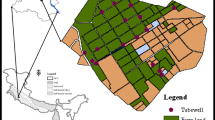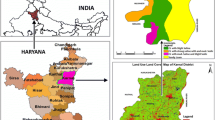Abstract
Accurate assessment of deep percolation (potential groundwater recharge) under different field crops is essential for sustainable management of scarce water resources and proper planning of crop rotation in irrigated, semi-arid regions of the world. The potential recharge from commonly grown field crops in semi-arid Indo-Gangetic Plain (IGP) of India was estimated using HYDRUS-1D model, where, irrigation, evapotranspiration, and soil moisture dynamics were simulated. Simultaneously, net groundwater use by different cropping patterns was also calculated. Among the hydraulic parameters, n was found most sensitive for water percolation. During rainy season, 293.8 and 159.1 mm water was percolated below the root zone of cotton and soybean, respectively, which accounted for 39.4 and 32.9% of the water input. During winter season, 66.8 and 30.3 mm water was percolated below the root zone of winter maize and mustard, respectively, accounting for 20.5 and 10.6% of added water. It was observed that net groundwater use was positive for cotton, soybean, and summer maize with the values of 168.8, 159.1, and 18.0 mm year−1, respectively, and negative for rice, wheat, winter maize, and mustard. For the eight most important cropping patterns of semi-arid IGP, the net groundwater use was negative and varied between − 4.4 mm year−1 for cotton-maize and −423 mm year−1 for rice-wheat. With these cropping patterns, the overall rate of decline of groundwater was 231 mm year−1. It was found that maize-wheat and soybean-wheat cropping patterns consume much less water than rice-wheat cropping pattern and therefore are suitable to arrest the declining trend of groundwater in semi-arid IGP of India.








Similar content being viewed by others
References
Ahmed, M., Chakraborty, D., Aggarwal, P., Bhattacharyya, R., & Singh, R. (2018). Modeling soil water dynamics and crop water use in a soybean-wheat rotation under chisel tillage in a sandy clay loam soil. Geoderma, 327, 13–24.
Allen, R. G., Pereira, L. S., & Raes, D. (1998). Crop evapotranspiration. Guidelines for computing crop water requirements. Irrigation and drainage paper No. 56. Rome: FAO.
Beyene, A., Cornelis, W., Verhoest, N. E. C., Tilahun, S., Alamirew, T., Adgo, E., Pue, J. D., & Nyssen, J. (2018). Estimating the actual evapotranspiration and deep percolation in irrigated soils of a tropical floodplain, northwest Ethiopia. Agric Water Manag, 202, 42–56.
Black, C. A. (1965). Methods of soil analysis: Part I physical and mineralogical properties. Madison: American Society of Agronomy.
CGWB. (2016). Aquifer mapping and groundwater management plan of NCT Delhi (p. 163). New Delhi: Central Ground Water Board, State Unit Office.
Dash, C. J., Sarangi, A., Singh, D. K., Singh, A. K., & Adhikary, P. P. (2015). Prediction of root zone water and nitrogen balance in an irrigated rice field using a simulation model. Paddy Water Environ, 13, 281–290.
Dash, C. J., Sarangi, A., Adhikary, P. P., & Singh, D. K. (2016a). Soil water budgeting approach to quantify potential groundwater recharge from croplands and groundwater use in a semi-arid region. Environ Earth Sci, 75(853). https://doi.org/10.1007/s12665-016-5620-7.
Dash, C. J., Sarangi, A., Adhikary, P. P., & Singh, D. K. (2016b). Simulation of nitrate leaching under maize-wheat cropping system in a semiarid irrigated area of the Indo-Gangetic Plain, India. J Irrig Drain Eng (ASCE), 142(2), 04015053. https://doi.org/10.1061/(ASCE)IR.1943-4774.0000965.
Dugas, W. A. (1989). Plant spacing effects on net irradiance extinction in cotton. Theor Appl Climatol, 40, 93–99.
Feddes, R. A., Kowalik, P. J., & Zaradny, H. (1978). Simulation of field water use and crop yield. New York: John Wiley and Sons.
Flenet, F., Kiniry, J. R., Board, J. E., Westgate, M. E., & Reicosky, D. C. (1996). Row spacing effects on light extinction coefficients of corn, sorghum, soybean and sunflower. Agron J, 88, 185–190.
Food and Agriculture Organization of the United Nations. (2013). FAO Statistical Yearbook 2013. World Food and Agriculture, 289.
Forkutsa, I., Sommer, R., Shirokova, Y. I., Lamers, J. P. A., Kienzler, K., Tischbein, B., Martius, C., & Vlek, P. L. G. (2009). Modeling irrigated cotton with shallow groundwater in the Aral Sea basin of Uzbekistan: I. Water dynamics. Irrig Sci, 27(4), 331–346.
Foster, S. S. D., & Chilton, P. J. (2003). Groundwater: the processes and global significance of aquifer degradation. Philos Trans R Soc B: Biol Sci, 358, 1957–1972.
Han, M., Zhao, C., Šimůnek, J., & Feng, G. (2015). Evaluating the impact of groundwater on cotton growth and root zone water balance using HYDRUS-1D coupled with a crop growth model. Agric Water Manag, 160, 64–75.
Hu, K., Li, B., Chen, D., Zhang, Y., & Edis, R. (2008). Simulation of nitrate leaching under irrigated maize on sandy soil in desert oasis in inner magnolia, China. Agri Water Manag, 95, 1180–1188.
Huo, S., Menggui, J., Liang, X., & Lin, D. (2014). Changes of vertical groundwater recharge with increase in thickness of vadose zone simulated by one-dimensional variably saturated flow model. J Earth Sci, 25(6), 1043–1050.
Jalota, S. K., & Arora, V. K. (2002). Model-based assessment of water balance components under different cropping systems in north-west India. Agri Water Manag, 57(1), 75–87.
Jimenez-Martinez, J., van Genuchten, M. T., & Candela, L. (2009). A root zone modelling approach to estimating groundwater recharge from irrigated areas. J Hydrol, 367, 138–149.
Kar, G., Kumar, A., & Martha, M. (2007). Water use efficiency and crop coefficient of dry season oil seed. Agric Water Manag, 87, 73–82.
Kendy, E., Gérard-Marchant, P., Walter, M. T., Zhang, Y., Liu, C., & Steenhuis, T. S. (2003). A soil water-balance approach to quantify groundwater recharge from irrigated cropland in the North China Plain. Hydrol Proc, 17, 2011–2031.
Le Coz, M., Favreau, G., & Ousmane, S. D. (2013). Modeling increased groundwater recharge due to change from rainfed to irrigated cropping in a semiarid region. Vadose Zone J, 12(2), 1–12. https://doi.org/10.2136/vzj2012.0148.
Lenka, S., Singh, A. K., & Lenka, N. K. (2009). Water and nitrogen interaction on soil profile water extraction and ET in maize-wheat cropping system. Agric Water Manag, 96(2), 195–207.
Leterme, B., Mallants, D., & Jacques, D. (2012). Sensitivity of groundwater recharges using climatic analogues and HYDRUS-1D. Hydrol Earth Syst Sci, 16, 2485–2497.
Lindquist, J. L., Arkebauer, T. J., Walters, D. T., Cassman, K. G., & Dobermann, A. (2005). Maize radiation use efficiency under optimal growth conditions. Agron J, 97, 72–78.
Lu, X., Jin, M., van Genuchten, M. T., & Wang, B. (2011). Ground water recharge at five representative sites in the Hebei Plain of China: case study. Ground Water, 49(2), 286–294.
Marechal, J. C., Dewandel, B., Ahmed, S., Galeazzi, L., & Zaidi, F. K. (2006). Combined estimation of specific yield and natural recharge in a semi-arid groundwater basin with irrigated agriculture. J Hydrol, 329, 281–293.
Mohan, S., Arumugam, N. (1994) Crop coefficients of major crops in South India. Agricultural Water Management 26(1–2):67–80
Nash, J. E., & Sutcliffe, J. V. (1970). River flow forecasting through conceptual models part I: a discussion of principles. J Hydrol, 10(3), 282–290.
O’Connell, M. G., O’Leary, G. J., Whitfield, D. M., & Connor, D. J. (2004). Interception of photosynthetically active radiation and radiation-use efficiency of wheat, field pea and mustard in a semi-arid environment. Field Crops Res, 85, 111–124.
Pachepsky, Y. A., Smettem, K. R. J., Vanderborght, J., Herbst, M., Vereecken, H., & Wosten, J. H. M. (2004). Reality and fiction of models and data in soil hydrology. In R. A. Feddes et al. (Eds.), Unsaturated zone modeling. Dordrecht: Kluwer Academic Publishers.
Patel, N., & Rajput, T. B. S. (2008). Dynamics and modeling of soil water under subsurface drip irrigated onion. Agric Water Manag, 95, 1335–1349.
Patil, N. G., Tiwari, P., Bhattayachaarya, T., & Nair, K. M. (2014). Natural resources of the Indo-Gangetic Plains: a land use planning perspective. Curr Sci, 107, 1537–1549.
Rodell, M., Velicogna, I., & Famiglietti, J. S. (2009). Satellite-based estimates of groundwater depletion in India. Nature, 460, 999–1002. https://doi.org/10.1038/nature.08238.
Rushton, K. R., Eilers, V. H. M., & Carter, R. C. (2006). Improved soil moisture balance methodology for recharge estimation. J Hydrol, 318, 379–399.
Saâdi, M., Zghibi, A., & Kanzari, S. (2018). Modeling interactions between saturated and un-saturated zones by Hydrus-1D in semi-arid regions (plain of Kairouan, Central Tunisia). Environ Monit Assess, 190(170). https://doi.org/10.1007/s10661-018-6544-3.
Safriel, U., & Adeel, Z. (2005). Dryland systems. In R. Hassan et al. (Eds.), Ecosystems and human well-being, current state and trends (Vol. 1, pp. 625–658). Washington: Island Press.
Scanlon, B. R., Healy, R. W., & Cook, P. G. (2002). Choosing appropriate techniques for quantifying groundwater recharge. Hydrogeol J, 10, 18–39.
Scanlon, B., Keese, K., Reedy, R. C., Simunek, J., & Andraski, B. J. (2003). Variations in flow and transport in thick desert vadose zones in response to paleoclimatic forcing (0–90 kyr): monitoring, modeling, and uncertainties. Water Resour Res, 39(7), 1179. https://doi.org/10.1029/2002WR001604.
Seiler, K. P., & Gat, J. (2007). Groundwater recharge from run-off, infiltration and percolation. Water Sci Technol Li (Vol. 55). Dordrecht: Springer.
Siebert, S., Henrich, V., Frenken, K., & Burke, J. (2013) Update of the digital global map of irrigation areas to version 5. Rheinische FriedrichWilhelms-Universitat, Bonn, Germany and FAO, Rome, Italy, p. 170.
Šimunek, J. (2015). Estimating groundwater recharge using HYDRUS 1D. Bulgarian Academy of Sciences. Eng Geol Hydrogeol, 29, 25–36.
Šimunek, J., van Genuchten, M. T., & Šejna, M. (2009). The HYDRUS-1D software package for simulating the movement of water, heat, and multiple solutes in variability saturated media. Department of Environmental Sciences, University of California, Riverside.
Tafteh, A., & Sepaskhah, A. R. (2012). Application of HYDRUS-1D model for simulating water and nitrate leaching from continuous and alternate furrow irrigated rapeseed and maize fields. Agric Water Manag, 113, 19–29.
Tyagi, N. K., Sharma, D. K., & Luthra, S. K. (2003). Determination of evapotranspiration for maize and berseem clover. Irrig Sci, 21, 173–181.
Van Genuchten, M. T. (1980). A closed-form equation for predicting the hydraulic conductivity of unsaturated soils. Soil Sci Soc Am J, 44(5), 892–898.
Yang, X., Chen, Y., Pacenka, S., Gao, W., Zhang, M., Sui, P., & Steenhuis, T. S. (2015). Recharge and groundwater use in the north China plain for six irrigated crops for an eleven year period. PLOS ONE, 10(1), e0115269. https://doi.org/10.1371/journal.pone.0115269.
Yu, G. R., Zhuang, J., Nakayama, K., & Yan, J. (2007). Root water uptake and profile soil water as affected by vertical root distribution. Plant Ecol, 189, 15–30. https://doi.org/10.1007/s11258-006-9163-y.
Zeng, W. Z., Xu, C., Wu, J. W., & Huang, J. S. (2014). Soil salt leaching under different irrigation regimes: HYDRUS-1D modelling and analysis. J Arid Land, 6(1), 44–58.
Author information
Authors and Affiliations
Corresponding author
Additional information
Publisher’s note
Springer Nature remains neutral with regard to jurisdictional claims in published maps and institutional affiliations.
Rights and permissions
About this article
Cite this article
Dash, C.J., Sarangi, A., Singh, D.K. et al. Numerical simulation to assess potential groundwater recharge and net groundwater use in a semi-arid region. Environ Monit Assess 191, 371 (2019). https://doi.org/10.1007/s10661-019-7508-y
Received:
Accepted:
Published:
DOI: https://doi.org/10.1007/s10661-019-7508-y




